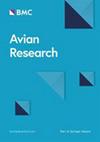鸟类适应性进化中珠蛋白的通道化
IF 1.7
2区 生物学
Q1 ORNITHOLOGY
引用次数: 0
摘要
珠蛋白超家族是氧气级联动力学的核心,它举例说明了通道化——表型特征的进化稳定——如何使脊椎动物在极端环境中茁壮成长。在鸟类中,血红蛋白(Hbs)是这一过程的范例,其结构和功能的沟通支撑着它们卓越的有氧能力和海拔多样化。尽管珠蛋白在我们对鸟类有氧适应的理解方面取得了重大进展,但要充分阐明它们在氧气稳态中的作用,必须综合考虑功能多样性、分子进化和结构创新。结合珠蛋白功能多样性和结构进化的观点,本文探讨了偶然性(突变/固定偏差)和偶然性(历史遗传/上位性约束)如何塑造血红蛋白的分化和平行性,从而将分子机制与鸟类的生理适应联系起来。我们强调了鸟类Hbs是如何通过代偿替代和变构调节来实现进化稳健性和适应可塑性之间的平衡的。然而,关键的空白仍然存在:未充分研究的珠蛋白(例如,神经珠蛋白,珠蛋白E)的作用和迁移类群的遗传同化机制。我们提出了一个整合生态差异(海拔、飞行耐力)、系统发育时间尺度和系统生物学的综合框架,以揭示渠化如何指导适应性妥协。通过关注羊膜内的鸟类,这一综合提出了脊椎动物进化的内聚模型,其中,管道球蛋白调和代谢精度与生态创新。最后,这篇综述完善了氧级联进化的假设,并呼吁跨学科研究来解码极端环境下适应性管道的遗传和生理结构。本文章由计算机程序翻译,如有差异,请以英文原文为准。
Canalization of globins in the adaptive evolution of birds
The globin superfamily, central to oxygen (O2) cascade dynamics, exemplifies how canalization—evolutionary stabilization of phenotypic traits—enables vertebrates to thrive in extreme environments. In birds, hemoglobins (Hbs) serve as a paradigm of this process, with structural and functional canalization underpinning their exceptional aerobic capacity and elevational diversification. Despite significant advances of globins in our understanding of avian aerobic adaptation, a comprehensive synthesis of functional diversity, molecular evolution, and structural innovation is essential to fully elucidate their canalized roles in O2 homeostasis. Integrating perspectives on globin functional diversity and structural evolution, this review examines how chance (mutation/fixation biases) and contingency (historical genetic/epistatic constraints) shape Hb divergence and parallelism, thereby bridging molecular mechanisms with physiological adaptation in birds. We highlight how avian Hbs, canalized through compensatory substitutions and allosteric regulation, achieves a balance between evolutionary robustness and adaptive plasticity. However, critical gaps remain persist: the roles of understudied globins (e.g., neuroglobin, globin E) and the mechanisms of genetic assimilation in migratory taxa. We propose an integrative framework that incorporates ecological divergence (elevation, flight endurance), phylogenetic timescales, and systems biology to unravel how canalization directs adaptive compromise. By focusing on birds within the amniotes, this synthesis advances a cohesive model for vertebrate evolution, wherein canalized globins reconcile metabolic precision with ecological innovation. Ultimately, this review refines hypotheses of O2 cascade evolution and calls for cross-disciplinary studies to decode the genetic and physiological architecture underlying adaptive canalization in extreme environments.
求助全文
通过发布文献求助,成功后即可免费获取论文全文。
去求助
来源期刊

Avian Research
ORNITHOLOGY-
CiteScore
2.90
自引率
16.70%
发文量
456
审稿时长
46 days
期刊介绍:
Avian Research is an open access, peer-reviewed journal publishing high quality research and review articles on all aspects of ornithology from all over the world. It aims to report the latest and most significant progress in ornithology and to encourage exchange of ideas among international ornithologists. As an open access journal, Avian Research provides a unique opportunity to publish high quality contents that will be internationally accessible to any reader at no cost.
 求助内容:
求助内容: 应助结果提醒方式:
应助结果提醒方式:


